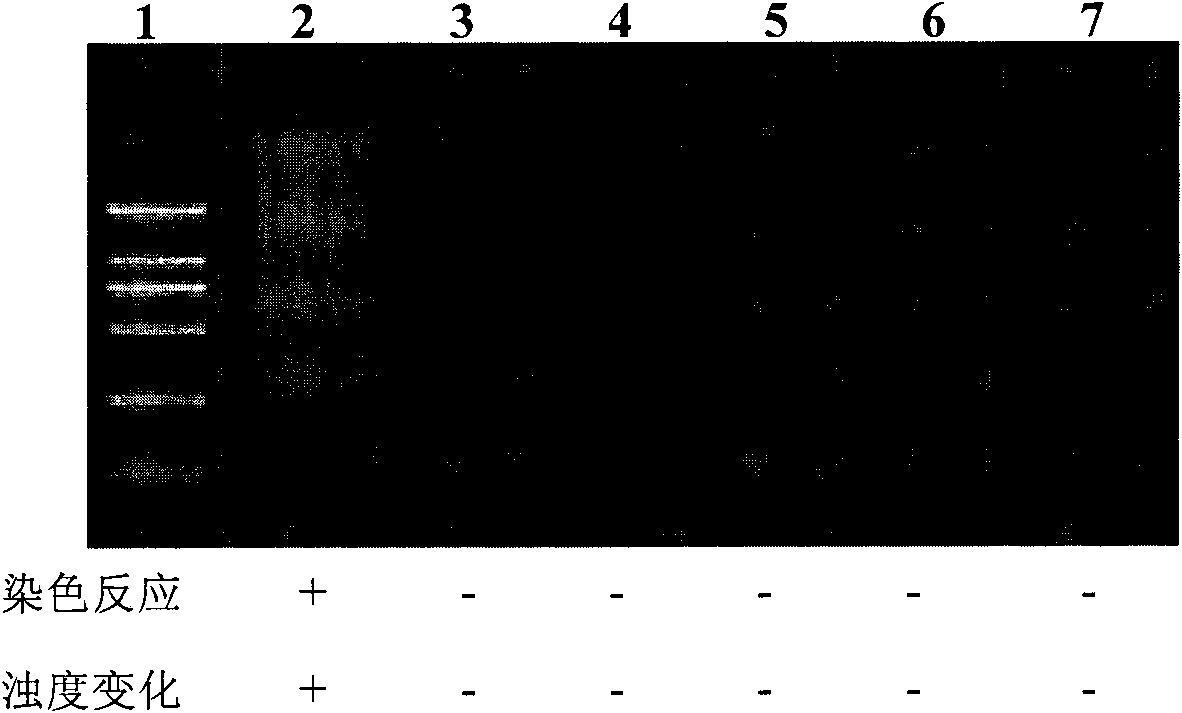Kit and oligonucleotide sequences for detecting astrovirus
A nucleotide sequence and astrovirus technology, applied in the biological field, can solve problems such as the detection of unseen astroviruses, achieve high specificity, improve detection sensitivity, and simple detection
- Summary
- Abstract
- Description
- Claims
- Application Information
AI Technical Summary
Problems solved by technology
Method used
Image
Examples
Embodiment 1
[0043] Example 1: Design of RT-LAMP primers
[0044] Referring to the highly conserved nucleic acid sequence (GenBank accession No.L23513) at the 5' end of the capsid protein coding gene (ORF2) of the type 1 astrovirus Oxford strain, use the Primer Explorer V4.0 online software (http: / / primerexplorer.jp / elamp4.0.0 / index.html) to design astrovirus-specific RT-LAMP primers, the primers are shown in Table 1. The Tm value of the primers is between 59°C and 65°C; the terminal free energy (G) is less than -4cal / mol, which can ensure the stability of the primers; the GC content is about 50%; there is no complementarity at the 3' end of the primers sequence, which can effectively prevent the formation of secondary structures inside the primer. The astrovirus-specific circular upstream primer (LF) and circular downstream primer (LB) designed in the present invention help to improve detection sensitivity and shorten reaction time. 6 primers recognize 8 different sites of the target g...
Embodiment 2
[0045] Example 2: Establishment and Optimization of Astrovirus RT-LAMP Detection System
[0046] 1. Method:
[0047] 1) Mg 2+ Concentration: Prepare the reaction mixture according to the reaction system in Table 2, and adjust the Mg 2+ Concentration to 2mM, 4mM, 6mM, 8mM, 10mM, 12mM, after incubation at 65°C for 90min, react at 85°C for 2min to terminate the reaction. Comparing different Mg 2+ Effect of concentration on amplification efficiency.
[0048] 2) Concentration of dNTPs: prepare the reaction mixture according to the reaction system in Table 2, adjust the final concentration of dNTPs to 0mM, 0.2mM, 0.6mM, 1.0mM, 1.4mM, 1.8mM respectively, and keep it at 65°C for 90min, then react at 85°C for 2min Stop the reaction. The effects of different concentrations of dNTPs on the amplification efficiency were compared.
[0049] 3) Betaine concentration: prepare the reaction mixture according to the reaction system in Table 2, and adjust the concentration of betaine to 0M,...
Embodiment 3
[0055] Embodiment 3: the composition of the test kit that detects Astrovirus
[0056] 1. The composition of the kit (stored at -20°C)
[0057] (1) TRIZOL lysate: purchased from Invitrogen, product number: 15596-026;
[0058] (2) DEPC water: purchased from Shanghai Sangong, item number: D1005;
[0059] (3) 2×RT-LAMP reaction solution: its components are: 2×ThermoPol buffer, 1.6M betaine, 3.6mM dNTPs, 8mM MgSO 4 , 0.4 μM Outer Upstream Primer (F3), 0.4 μM Outer Downstream Primer (B3), 3.2 μM Inner Upstream Primer (FIP), 3.2 μM Inner Downstream Primer (BIP), 1.6 μM Loop Upstream Primer (LF) and 1.6 μM Loop Like downstream primer (LB); Wherein the outer upstream primer (F3) is the nucleotide sequence shown in the sequence table SEQ ID No.1, and the outer downstream primer (B3) is the nucleotide sequence shown in the sequence table SEQ ID No.2 Sequence, the inside upstream primer (FIP) is the nucleotide sequence shown in the sequence table SEQ ID No.3, the inside downstream prim...
PUM
 Login to View More
Login to View More Abstract
Description
Claims
Application Information
 Login to View More
Login to View More - R&D
- Intellectual Property
- Life Sciences
- Materials
- Tech Scout
- Unparalleled Data Quality
- Higher Quality Content
- 60% Fewer Hallucinations
Browse by: Latest US Patents, China's latest patents, Technical Efficacy Thesaurus, Application Domain, Technology Topic, Popular Technical Reports.
© 2025 PatSnap. All rights reserved.Legal|Privacy policy|Modern Slavery Act Transparency Statement|Sitemap|About US| Contact US: help@patsnap.com



